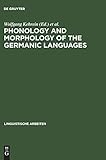Phonology and Morphology of the Germanic Languages / ed. by Wolfgang Kehrein, Richard Wiese.
Material type: TextSeries: Linguistische Arbeiten ; 386Publisher: Tübingen : Max Niemeyer Verlag, [2014]Copyright date: ©1998Edition: Reprint 2013Description: 1 online resource (298 p.) : Zahlr. AbbContent type:
TextSeries: Linguistische Arbeiten ; 386Publisher: Tübingen : Max Niemeyer Verlag, [2014]Copyright date: ©1998Edition: Reprint 2013Description: 1 online resource (298 p.) : Zahlr. AbbContent type: - 9783484303867
- 9783110919769
- 430 23
- PD131 ǂb P44 1998eb
- online - DeGruyter
- Issued also in print.
| Item type | Current library | Call number | URL | Status | Notes | Barcode | |
|---|---|---|---|---|---|---|---|
 eBook
eBook
|
Biblioteca "Angelicum" Pont. Univ. S.Tommaso d'Aquino Nuvola online | online - DeGruyter (Browse shelf(Opens below)) | Online access | Not for loan (Accesso limitato) | Accesso per gli utenti autorizzati / Access for authorized users | (dgr)9783110919769 |
Browsing Biblioteca "Angelicum" Pont. Univ. S.Tommaso d'Aquino shelves, Shelving location: Nuvola online Close shelf browser (Hides shelf browser)

|

|

|

|

|

|

|
||
| online - DeGruyter Nominalisierte Infinitive : Eine empirisch basierte Studie zum Deutschen / | online - DeGruyter Models of Inflection / | online - DeGruyter Ein phonetisches Modell der Sprachproduktion / | online - DeGruyter Phonology and Morphology of the Germanic Languages / | online - DeGruyter Der Streit um Luthers Bibelverdeutschung im 16. und 17. Jahrhundert. Teil 1, Mit der Identifizierung Friedrich Traubs. | online - DeGruyter Formale und transzendentale Logik : Versuch einer Kritik der logischen Vernunft / | online - DeGruyter Türkisch sprechen nicht nur die Türken : Über die Unschärfebeziehung zwischen Sprache und Ethnie in Deutschland / |
Frontmatter -- Table of contents -- Preface -- Section I: Phonology -- Vowel shortness in Icelandic -- The role of coronal specification in German and Dutch phonology and morphology -- Consonant epenthesis: its distribution and phonological specification -- Towards a Scandinavian accent typology -- Section II: Prosodic morphology -- Stress preservation in German loan-words -- Phonological output constraints in morphology -- The structure of the German root -- Prosodic choices and the Dutch nominal plural -- Morphological haplology in a constraint-based morpho-phonology -- Section IIΙ: Morphology -- A case study in declarative morphology: German case inflection -- Against arbitrary features in inflection: Old English declension classes -- Heads or phrases? Particles in particular -- Addresses of contributors
restricted access online access with authorization star
http://purl.org/coar/access_right/c_16ec
The papers collected in this volume apply principles of phonology and morphology to the Germanic languages. Phonological phenomena range from subsegmental over phonemic to prosodic units (as syllables, pitch accent, stress). Morphology includes properties of roots, derivation, inflection, and words. The analyses deal with language-internal and comparative aspects, covering the whole (European) range of Germanic languages. From a theoretical perspective, most papers concentrate on constraint-based approaches. Crucial to those theories are principles of the phonology-morphology interaction, both within and between languages. The well documented Germanic languages provide an excellent field for research and almost all papers deal with aspects of the interface.
Issued also in print.
Mode of access: Internet via World Wide Web.
In English.
Description based on online resource; title from PDF title page (publisher's Web site, viewed 28. Feb 2023)


